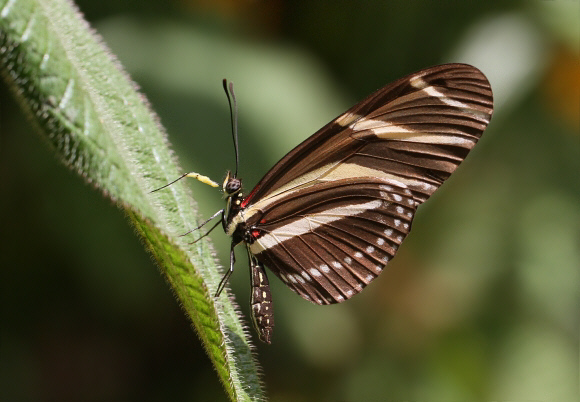![]() Heliconius charithonia Medellin, Colombia – Adrian Hoskins
Heliconius charithonia Medellin, Colombia – Adrian Hoskins
Introduction
The tribe Heliconiini, colloquially known as Longwings, includes 71 species, all confined exclusively to the neotropics. The Heliconiini includes the genera Heliconius, Podotricha, Dryas, Agraulis, Dione, Dryadula, Eueides, Neruda, Laparus and Philaethria.
The 39 Heliconius species are much studied by geneticists and taxonomists. Many of them produce a staggering variety of colour forms – Heliconius erato e.g. produces no less than 29 geographical forms, each of which corresponds almost exactly in colour and pattern to a ‘sister’ subspecies of Heliconius melpomene flying in the same area.
All Heliconius species have elongated black wings, marked with simple but striking patterns usually featuring streaks or patches of red and cream, or blue and cream. A few, such as sara, antiochus and wallacei have a metallic blue sheen over the basal area of both wings. All are characterised by their delicate fluttering flight, long straight antennae, and fondness for flowers.
Heliconius charithonia is distributed from the southern USA and Mexico to Ecuador, and also occurs on the Caribbean islands of Trinidad, Cuba, Haiti, Antigua, Jamaica and the southern USA.
![]() Heliconius charithonia Medellin, Colombia – Adrian Hoskins
Heliconius charithonia Medellin, Colombia – Adrian Hoskins
Habitats
This species is found in sub-tropical rainforest, forest edge habitats, hammocks, pastures, and along roadsides at elevations between sea level and about 1700m.
Lifecycle
The eggs are laid either singly or loose groups of up to a dozen on leaf buds or leaves of Passiflora or Tetrastylis ( Passifloraceae ). The caterpillar when fully grown is white, marked with black spots. Each body segment bears 6 long black barbed spines, and there is another pair of similar spines on the head. The chrysalis looks like a dead twisted leaf. It is ochreous-brown, and possesses a pair of long and twisted head horns, several curved dorsal spines, and a series of tiny hook-like spines along the costa of the wing cases. It is suspended by the cremaster from a stem or leaf.
Adult behaviour
Heliconius butterflies are characterised by having a very delicate fluttering flight, particularly when hovering around flowers. They commonly nectar at Hamelia, Lantana and Stachytarpheta.
Unlike other butterflies, Heliconius females feed on pollen as well as nectar. Studies of ethilla have shown that females deprived of pollen can only produce about 15% of the number of eggs laid by females that have access to it. This probably applies equally to other Heliconius species including melpomene. The pollen from Psiguria, Anguria and Gurania flowers provides amino acids that can’t be obtained from nectar or other sources, and contributes greatly to the longevity of the butterflies – some Heliconius species are known to live for up to 9 months as adults.

Heliconius charithonia with pollen basket adhering to proboscis, Colombia – Adrian Hoskins
Studies have shown that Heliconius butterflies have home ranges within which they can memorise the locations of nectar and pollen sources, host plants and communal roosting sites. They are able to plan the most efficient route by which to visit all nectar / pollen sources in the vicinity by using simple calculations akin to what mathematicians call the ‘travelling salesman algorithm’. Erlich & Gilbert demonstrated that individual butterflies memorise the location of particular Psiguria plants, which they visit daily, following a predefined circuit through the forest.
In the genus Heliconius most species rely entirely on airborne chemicals to locate mates. Males of hecale, ismenius and cydno are attracted by pheromones to the pupae of conspecific females. The day before emergence a female pupa will usually have several males in close attendance. A frantic battle takes place the instant she hatches, as the males all struggle to copulate with her, not even allowing her time to expand and dry her wings. In some other Heliconius species such as hecalesia, hewitsoni, erato, charithonia and sara the males don’t even wait until the female emerges. Instead they physically break open her pupa and copulate as soon as her genitalia are accessible.
Heliconius charithonia adults gather in the late afternoon to roost communally in groups of up to a 30 on twigs or tendrils, at a height of about 1-2m above ground level.
